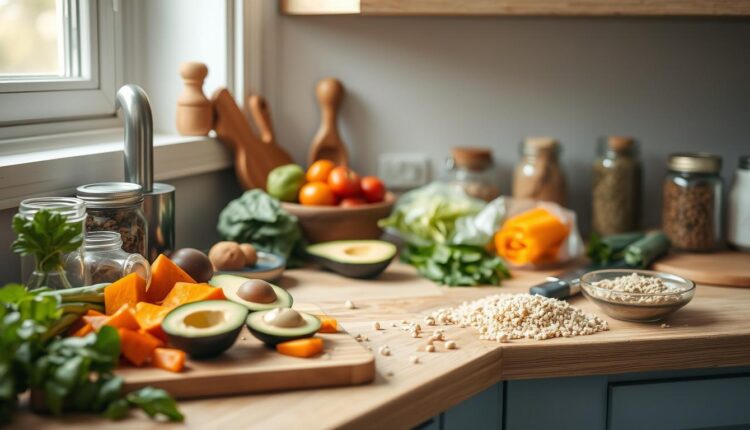Meal Prep For Work Vegetarian Options With Complete Proteins
Discover simple meal prep for work vegetarian options with complete proteins. Get practical tips and recipes for no-stress meals.
Did you know 60% of Americans want to eat more plant-based meals but worry about staying full? The secret lies in complete proteins – those magical nutrients that keep energy steady and cravings at bay. Whether you’re juggling back-to-back meetings or chasing deadlines, your midday fuel shouldn’t leave you rummaging for snacks by 3 PM.
I’ve spent years perfecting no-stress solutions for packed schedules. My kitchen mantra: “Batch once, eat all week.” Think vibrant chickpea salads with crunchy veggies, hearty pasta dishes loaded with lentils, and one-pan wonders that multitask like a pro. These recipes aren’t just tasty – they’re built to handle real life, from office fridges to last-minute schedule changes.
Planning is your ally here. A Sunday batch of marinated tofu or roasted chickpeas becomes tomorrow’s grab-and-go hero. And don’t worry – we’re skipping complicated techniques. You’ll find familiar ingredients transformed through smart prep (yes, even that jar of quinoa buried in your pantry).
Key Takeaways
- Complete proteins prevent energy crashes in meat-free lunches
- Simple batch-cooking creates 4+ meals in one session
- Versatile base recipes adapt to what’s in your fridge
Introduction to Vegetarian Meal Prep for Work
43% of professionals now pack meat-free midday meals at least twice weekly. This shift isn’t just about ethics – it’s fueled by smarter nutrition strategies that combat afternoon slumps. The magic lies in pairing ingredients that form complete protein profiles, keeping you sharp through those endless Zoom calls.
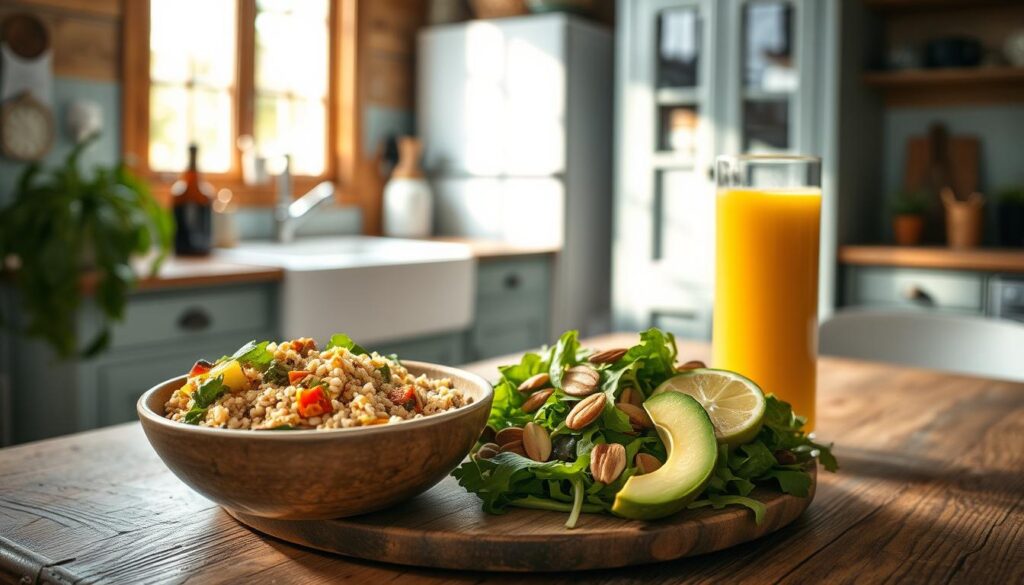
Why Protein Pairing Matters
Unlike animal products, most plant proteins lack one essential amino acid. Combine complementary sources like rice + beans or hummus + whole-grain pita, and you’ve got muscle-building power rivaling chicken breast. My clients often report fewer cravings after switching to these combos.
Meatless vs Traditional Prep: A Fresh Perspective
Vegetarian lunches often outlast meat-based ones in office fridges. Lentil soups and grain bowls stay vibrant for 4-5 days, while cooked chicken risks drying out by Wednesday. Try these swaps:
| Factor | Meat-Based | Plant-Based |
|---|---|---|
| Prep Time | 45-60 mins | 30-40 mins |
| Shelf Life | 3 days | 5 days |
| Flavor Versatility | Limited by protein | Endless spice options |
Batch-cooking grains every Sunday cuts weekday cooking time in half. For inspiration, these spicy chickpea wraps use pantry staples and take 20 minutes active time. Pro tip: Massage kale with lemon juice when prepping – it stays crisp all week!
Benefits of Vegetarian Meal Prep for Work
Workday lunches drain $3,000 annually from the average American’s wallet – but strategic planning flips that math. I’ve seen clients slash their food bills by 40% while boosting midday energy through smart ingredient combinations. The key? Treating your lunchbox like a nutrition lab where flavor and function collide.
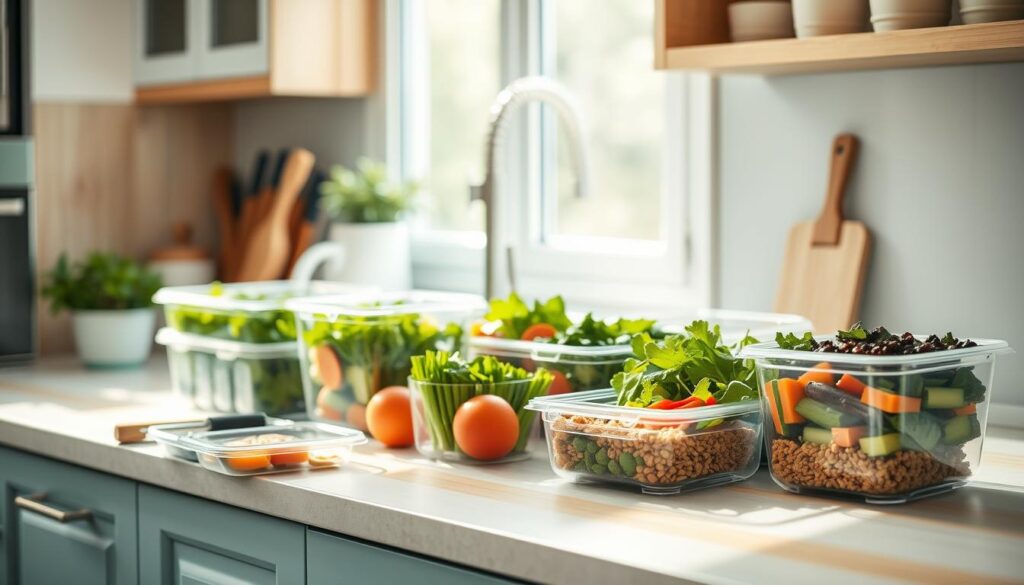
Nutritional and Energy Advantages
Plant-powered lunches deliver steady energy because they’re packed with fiber and complex carbs. A Johns Hopkins study found participants using complete protein pairings reported 23% fewer afternoon slumps. Try these combos:
| Base Ingredient | Pairing | Benefits |
|---|---|---|
| Quinoa | Black beans | 18g protein + iron boost |
| Brown rice | Lentils | Folate-rich + sustains focus |
| Whole wheat | Chickpeas | Fiber doubles vs white pasta |
“Plant-based meals with proper protein balance show measurable cognitive benefits within 3 days.” – Journal of Workplace Nutrition
Time and Cost Efficiency
Batch-cooking 4 servings of chili takes 15 extra minutes versus making one portion. That’s 75 minutes saved weekly! Compare costs:
| Item | Homemade | Takeout |
|---|---|---|
| Lentil stew | $2.10/serving | $12.95 |
| Grain bowl | $3.40 | $14.50 |
My 10-minute curry roasted chickpeas use pantry staples and stay crunchy all week. Toss them over greens or grain bowls – instant texture upgrade without daily effort.
Essential Components for Meal Prep for Work Vegetarian Options
Your lunchbox becomes a powerhouse when four elements work together: protein anchors, colorful plants, hearty grains, and flavor-packed sauces. These components transform desk dining from sad salads to satisfying experiences that keep afternoon brain fog at bay.
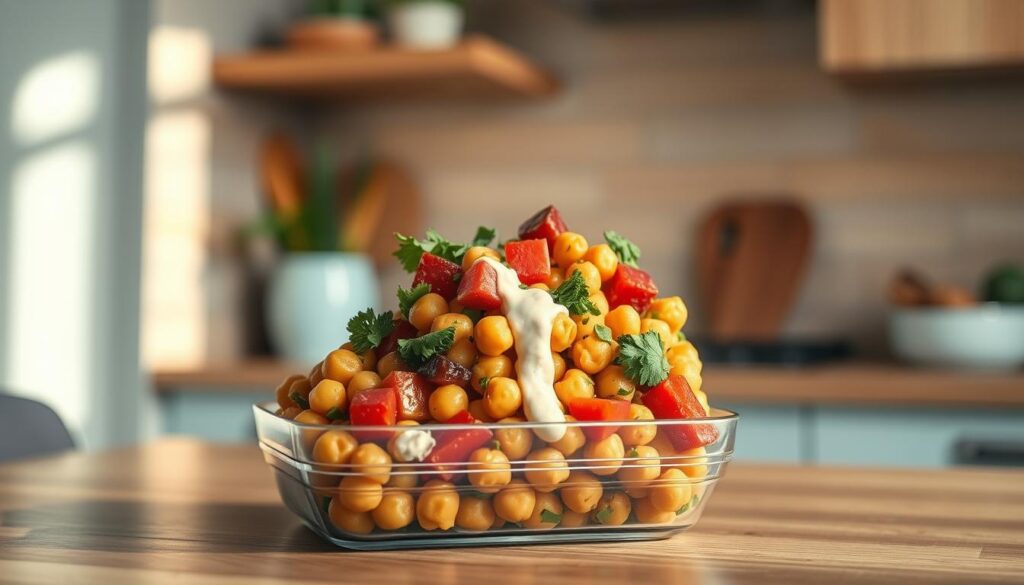
Protein Powerhouses That Satisfy
Chickpeas and lentils aren’t just pantry staples – they’re protein ninjas. One cup of cooked chickpeas delivers 15g protein, while edamame packs 18g per serving. My go-to combinations:
- Smoky roasted chickpeas over kale
- Lentil-walnut “meat” in wraps
- Tofu scramble with turmeric
These keep hunger pangs quiet for hours. Try marinating proteins Sunday night – flavors deepen by Tuesday’s lunch.
Veggies and Grains: The Dynamic Duo
Rotate three veggie types weekly for texture variety: crunchy (bell peppers), tender (zucchini), and leafy (spinach). Pair with quinoa or farro – their nutty flavors complement roasted vegetables beautifully. Pro tip: Cook grains in vegetable broth for instant flavor upgrade.
Sauces tie everything together. Whisk tahini-lemon dressing or bright ginger-scallion sauce to revive prepped components. Store separate from dry ingredients to maintain crunch.
Sunday batch-roasting transforms into Monday’s Mediterranean chickpea bowl and Wednesday’s stir-fry. Mix-and-match components prevent lunchtime boredom while maximizing weekly grocery investments.
Planning and Organizing Your Vegetarian Meal Prep
I learned the hard way that chaos follows when Sunday prep lacks strategy. Now, my fridge holds labeled containers like a Tetris champion – each ingredient ready to assemble into five distinct lunches. This system turns frantic mornings into grab-and-go victories.
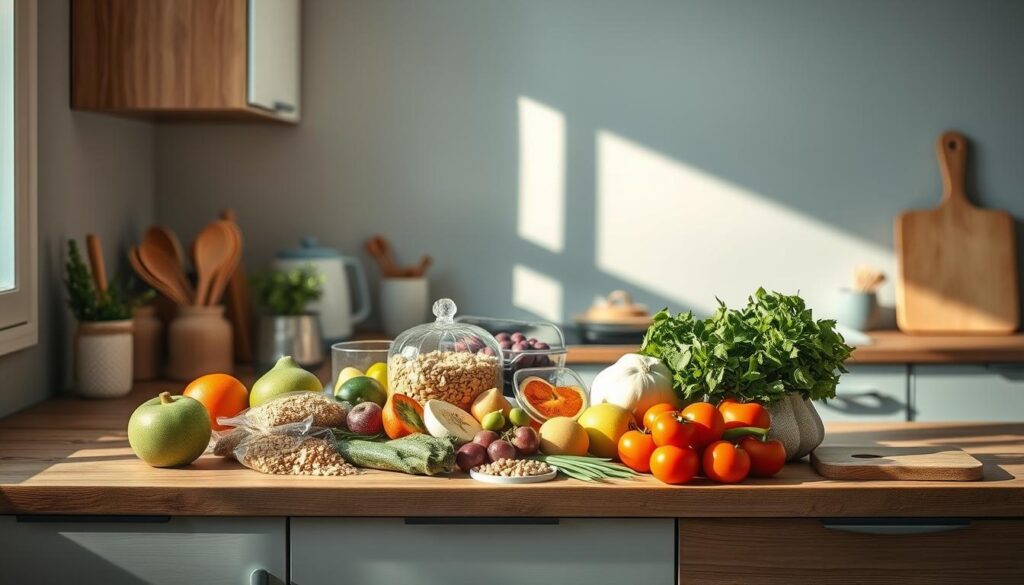
Meal Planning Strategies and Scheduling
Start by mapping your week’s rhythm. Block 90 minutes Sundays for batch-cooking quinoa and rice – these grains anchor multiple dishes. Mondays become stir-fry nights when you’ve pre-chopped broccoli and bell peppers. Need inspiration? My “three-batch rule” works wonders:
- Roast two sheet pans of veggies
- Simmer a big pot of seasoned beans
- Whisk three dressings (tahini, lemon-herb, spicy peanut)
This creates mix-and-match potential across five days without repetition.
Choosing the Right Ingredients for Each Day
Prioritize ingredients that improve with time. Marinated chickpeas gain flavor by Wednesday, while roasted sweet potatoes stay firm. Store dressings in small jars – they’ll keep greens crisp until lunchtime. Glass containers (Prepistry’s top picks) prevent sogginess and make stacking effortless.
Pro tip: Cook extra rice on Sunday. Tuesday’s burrito bowl becomes Thursday’s fried “rice” with leftover veggies and a fried egg. Versatile staples stretch your creativity while minimizing waste.
Quick and Easy Vegetarian Meal Prep Recipes
The sizzle of garlic hitting a hot skillet signals magic ahead. Busy days demand recipes that deliver bold flavors without babysitting pans – think zesty chickpea salads that improve overnight and pasta dishes ready before your rice cooker dings. These creations prove fast doesn’t mean bland.
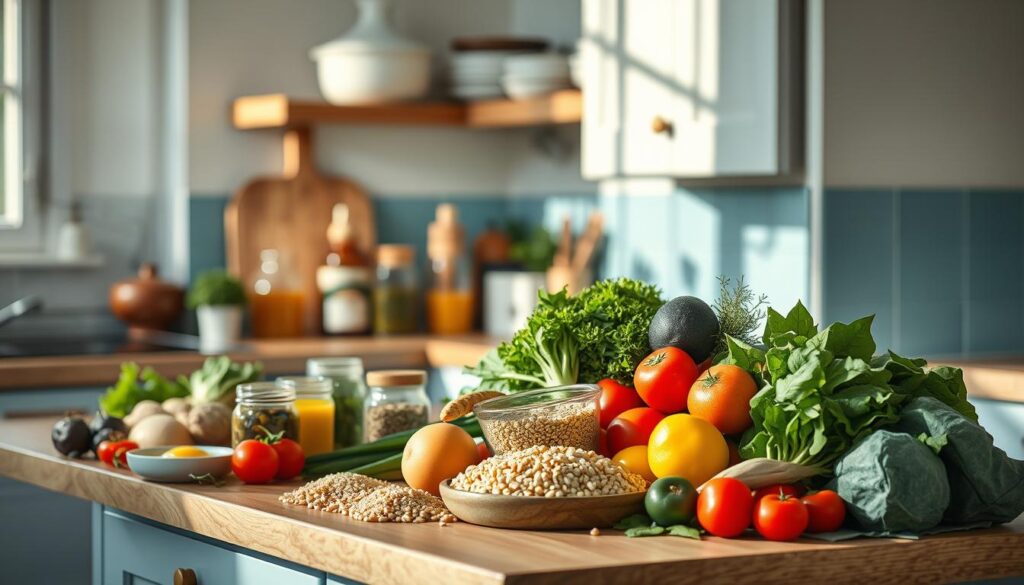
Chickpea Salad and Pasta Salad Variations
Transform humble beans into lunchtime stars. My Mediterranean Chickpea Salad combines roasted peppers, feta, and lemon-tahini dressing – it’s crunchier on day three. For pasta lovers, the Parmesan Spinach Mushroom Skillet uses one pan and 20 minutes. Try these twists:
| Base | Add-Ins | Prep Time |
|---|---|---|
| Chickpeas | Curry powder + golden raisins | 12 mins |
| Whole-grain pasta | Sun-dried tomatoes + pine nuts | 18 mins |
Double batches effortlessly become next-day dinners. Swap dressings to keep taste buds guessing – smoky paprika mayo or bright cilantro-lime work wonders.
Making Use of One-Pot and Stir-Fry Ideas
Your Dutch oven does heavy lifting here. The One-Pot Garlic Parmesan Pasta cooks noodles in veggie broth while wilting spinach. Leftovers? Toss with roasted broccoli for a new dish. Stir-fries shine with frozen veggies – they’re pre-chopped and budget-friendly.
“Single-pan recipes reduce cleanup time by 70% compared to traditional methods.” – Prepistry Test Kitchen
Adapt recipes effortlessly: use tamari instead of soy sauce for gluten-free needs, or add chili crisp for heat lovers. These low-effort solutions work as desk meals or rushed family dinners – no fancy skills required.
Using Complete Proteins to Enhance Meal Flavor
Flavor isn’t just about taste—it’s science meeting your lunchbox. Complete proteins like chickpeas and quinoa carry natural umami notes that amplify herbs and spices. When paired smartly, they create layered flavors rivaling restaurant dishes. Think smoky paprika clinging to roasted chickpeas or garlic-infused tahini elevating a simple bowl.

Creative Ingredient Pairings
Transform basic components into bold experiences. Try these combos:
| Protein | Flavor Boosters | Benefits |
|---|---|---|
| Chickpeas | Smoked paprika + lemon zest | Crispy texture, citrus tang |
| Black beans | Lime juice + cumin | Bright acidity, earthy warmth |
| Tempeh | Maple glaze + chili flakes | Sweet heat, caramelized crust |
Marinate proteins overnight in reusable containers—flavors intensify while you sleep. For time-crunched days, toss pre-chopped kale with lemon dressing and canned beans. Ready in 7 minutes.
“Layer flavors like a pro: acid (vinegar), fat (olive oil), and crunch (seeds) make every bite dynamic.” – Chef Callie
Store components separately to preserve textures. Glass jars keep dressings from wilting greens, while divided bento boxes prevent sogginess. Revive Thursday’s bowl by adding toasted nuts or fresh herbs—zero extra cooking required.
Creative Ideas for Make-Ahead Vegetarian Meals
Ever opened your fridge to find salad greens swimming in dressing? There’s a smarter way. I’ve discovered that strategic layering in Mason jars keeps ingredients crisp for days while turning lunch into a colorful experience. These portable powerhouses let you build flavor-packed dishes that actually improve with time.
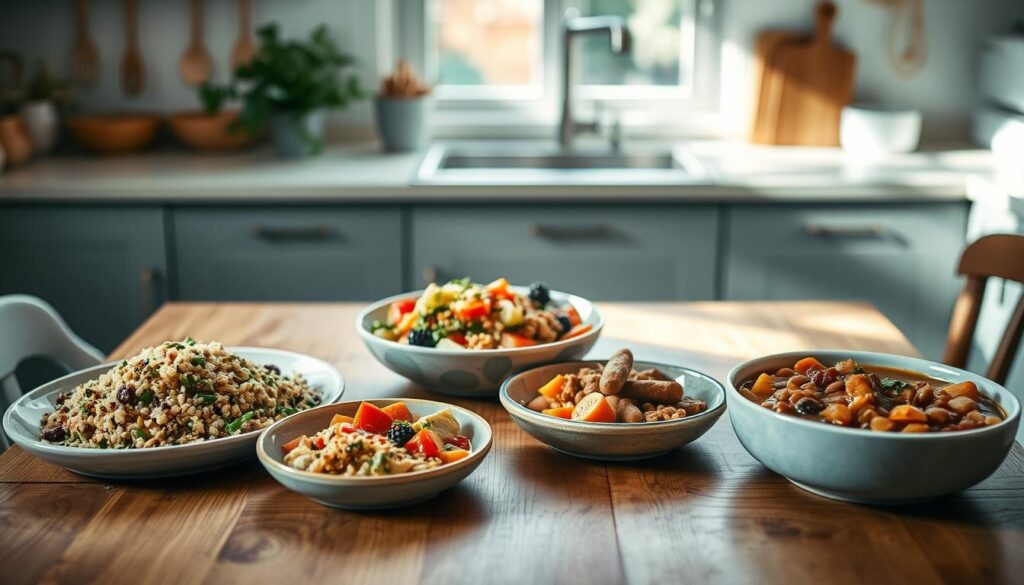
Mason Jar Salads and Grain Bowls
Start with dressings at the jar’s base – balsamic or lemon-tahini work best. Add hearty veggies like roasted peppers or shredded carrots next. Then layer grains and proteins before topping with delicate greens. This science-backed method prevents sogginess:
| Layer Order | Ingredients | Tip |
|---|---|---|
| 1 (Bottom) | Dressing | Use 2 tbsp max |
| 2 | Crunchy veggies | Bell peppers, cucumbers |
| 3 | Grains/Proteins | Quinoa + chickpeas |
| 4 (Top) | Greens + Toppings | Add avocado slices last |
For Mediterranean grain bowls, mix farro with cherry tomatoes, feta crumbles, and lemon-dressed kale. Freeze components like cooked grains in portioned bags – they’ll thaw by lunchtime.
“Freezing roasted veggies and grains separately preserves textures better than combined dishes.” – Prepistry Test Kitchen
Brighten meals with tri-color peppers or pickled red onions. Store dressings in small containers to drizzle before eating. These vibrant combinations turn desk lunches into moments you’ll actually anticipate.
| Freezer Component | Storage Time | Reheating Tip |
|---|---|---|
| Cooked grains | 3 months | Microwave with damp paper towel |
| Roasted veggies | 2 months | Oven at 375°F for crispness |
| Marinated beans | 1 month | Thaw overnight in fridge |
Tips for Storing and Reheating Vegetables and Proteins
Ever opened your lunch container to find soggy veggies or rubbery tofu? The difference between “meh” and “wow” often comes down to storage smarts. Let’s turn your fridge into a flavor-saving fortress.
Container Recommendations and Storage Best Practices
Glass containers are my weekday heroes. Unlike plastic, they don’t absorb odors and handle microwave heat without warping. Try this system:
| Material | Best For | Shelf Life |
|---|---|---|
| Glass | Reheating, saucy dishes | 5 days |
| BPA-free plastic | Cold items, dressings | 3 days |
| Stainless steel | Portable grain bowls | 4 days |
Layer ingredients strategically. Keep dressings in small jars – pour them over greens just before eating. For pasta salad, store crunchy veggies separately to maintain texture.
Reheating Techniques for Preserving Flavor
Microwave smarter: Cover dishes with a damp paper towel to lock in moisture. Stir in 1 tsp water before reheating saucy dishes like curries. Oven lovers? Roast pre-cooked veggies at 375°F for 5 minutes to revive crispness.
| Dish Type | Method | Pro Tip |
|---|---|---|
| Stir-fries | Skillet on medium | Add fresh garlic at the end |
| Grain bowls | Microwave + 30 sec rest | Mix in spices after heating |
“Treat reheating like seasoning – a quick refresh beats overcooking.” – Chef Callie
Imagine opening your fridge to find lunches that fuel your week without last-minute stress. This guide showed how smart planning transforms plant-powered eating from complicated to effortless. Complete proteins like quinoa and black bean combos keep energy steady, while batch-cooking turns Sunday afternoons into weekday wins.
Remember these essentials: Pair grains with legumes for maximum nutrition. Use mason jar layering to keep components crisp. Rotate three base recipes to prevent boredom. My marinated black bean bowls prove easy make dishes can dazzle taste buds – just add lime and cilantro.
Your journey starts small. Try one make ahead soup or salad easy enough for rushed mornings. Share your creations with #PrepistryEats – our community thrives on real-life kitchen wins. Got leftover roasted veggies? Toss them with black bean salsa for tomorrow’s mason jar masterpiece.
Hungry for more? Bookmark this guide and revisit when inspiration wanes. I’ll keep adding time-saving twists – because good food shouldn’t complicate life. Now grab those containers and start your flavor revolution!
Quinoa Edamame Power Lunch Jars
These vibrant quinoa edamame lunch jars are packed with complete proteins, crunchy veggies, and a tangy sesame-ginger dressing for all-day energy.
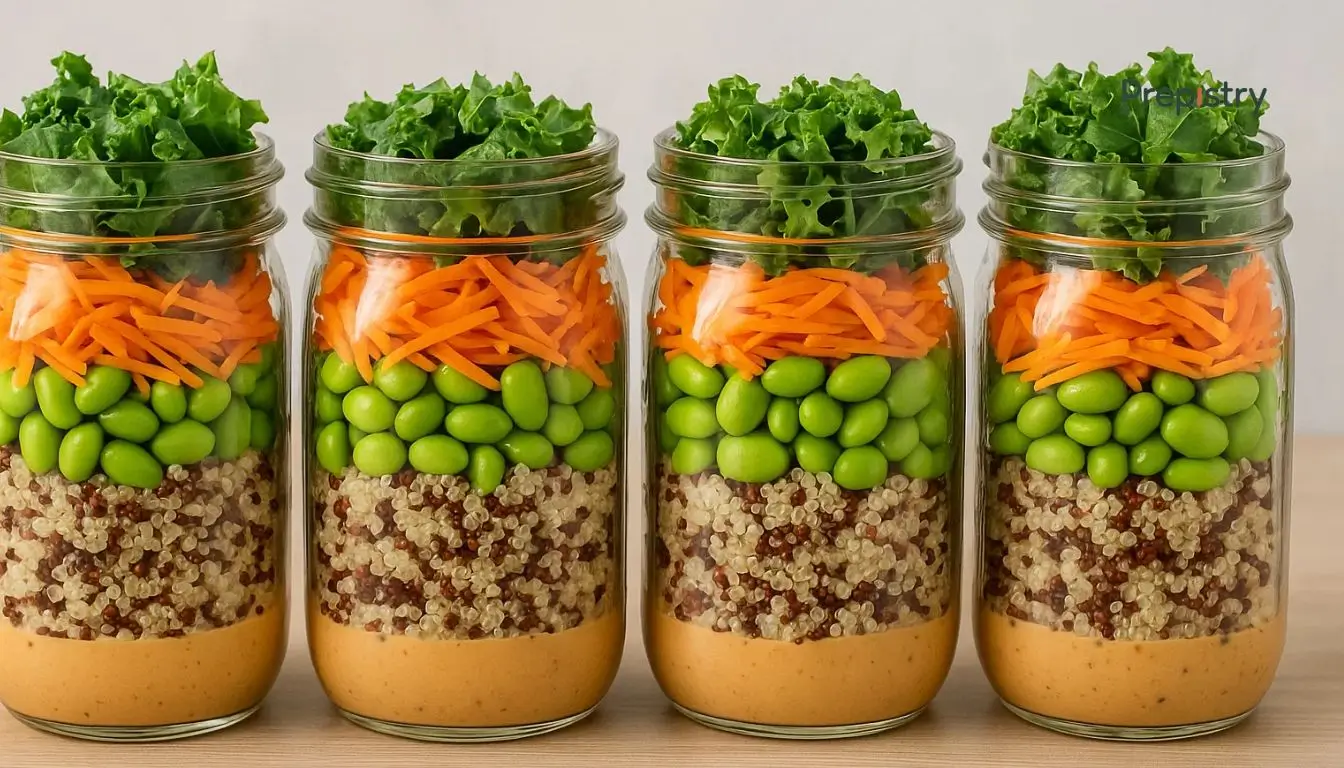
Nutrition Information
Equipment Needed
- Medium saucepan
- Mason jars or airtight containers
- Whisk
- Mixing bowls
Ingredients
-
1 cup quinoa, rinsed
-
2 cups vegetable broth
-
1 1/2 cups shelled edamame, cooked
-
1 red bell pepper, diced
-
1 cup shredded purple cabbage
-
1 carrot, julienned
-
1/4 cup chopped scallions
-
2 tablespoons sesame seeds
-
1/3 cup rice vinegar
-
2 tablespoons toasted sesame oil
-
1 tablespoon tamari or soy sauce
-
1 tablespoon maple syrup
-
1 teaspoon grated fresh ginger
-
1 teaspoon sriracha (optional)
Instructions
Recipe Video
EASY & HEALTHY QUINOA BOWLS ‣‣ 6 Awesome Ways!
Discover six delicious and nutritious quinoa bowl recipes that are perfect for meal prep, lunch, or dinner. These easy-to-make bowls are packed with flavor and health benefits, making them a great addition to your weekly meal plan.

